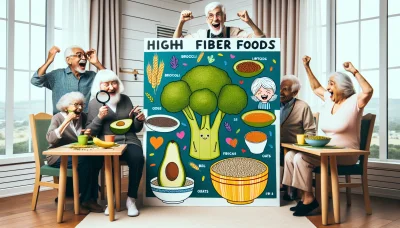What foods are high in fiber and low in carbs Quiz
Test Your Knowledge
Question of
Understanding Fiber and Carbohydrates
The Role of Fiber in Your Diet
Fiber is a superstar in the world of nutrition, playing a critical role in digestion. Unlike other food components, fiber isn't digested by your body. Instead, it passes relatively intact through your stomach, small intestine, and colon, and out of your body. It's this journey through your digestive system that gives fiber its power to influence health.
Including fiber in your daily diet can lead to significant health perks. It normalizes bowel movements and helps maintain bowel health. But that's not all fiber has been linked to lower cholesterol levels, helping control blood sugar levels and aiding in achieving a healthy weight.
Health Benefits of Dietary Fiber
Dietary fiber is like the unsung hero of the nutrient world. It has a hand in reducing the risk of several chronic diseases. For instance, adequate fiber intake is associated with a lower risk of heart disease thanks to its ability to lower cholesterol. Plus, it can also reduce the odds of developing type 2 diabetes and certain types of cancer.
Let's not overlook how fiber makes you feel fuller longer which is fantastic news for weight management! This satiety factor can prevent overeating by curbing hunger pangs. And for those who struggle with constipation or irregular stools, fiber increases the weight and size of your stool and softens it, making it easier to pass.
Recommended Daily Fiber Intake
So how much fiber should you be eating? The Institute of Medicine suggests that men under 50 should aim for 38 grams per day, while women under 50 need 25 grams per day. Above 50 years old? Men should reduce their intake to 30 grams per day and women to 21 grams per day. These recommendations ensure you reap all the health benefits without going overboard.
Differentiating Between Carbs
Simple vs. Complex Carbohydrates
Carbohydrates are often vilified, but they're an essential energy source for our bodies. They come in two main types: simple and complex. Simple carbs are sugars that provide quick energy but little nutritional value think candy and sodas. Complex carbs, on the other hand, are found in foods like whole grains and legumes; they break down slowly and offer vitamins, minerals, and fibers.
Impact on Blood Sugar Levels
The type of carbs you consume affects your blood sugar levels differently. Simple carbs cause spikes in blood sugar levels followed by crashes, which can lead to feelings of fatigue and hunger. In contrast, complex carbohydrates have less immediate impact due to their slower digestion rate, providing a more sustained energy release.
Balancing Fiber and Carbs for Optimal Health
Strategies for Low-Carb, High-Fiber Eating
- Incorporate Vegetables: Fill half your plate with non-starchy vegetables; theyre low in carbs and high in fiber.
- Select Whole Grains: Choose whole grains over refined grains to increase your fiber intake without adding too many carbs.
- Eat Legumes: Beans, lentils, and peas are excellent sources of both protein and fiber while still being moderate in carbs.
- Leverage Nuts and Seeds: A handful of nuts or seeds can provide a satisfying crunch along with fiber and healthy fats.
- Beware of Added Sugars: Read labels carefully as many processed foods add sugars that increase carb content without any beneficial nutrients.
- Favor Whole Fruit: Opt for whole fruits instead of juices as they contain more fiber and less sugar per serving.
Identifying Hidden Carbs in Foods
Finding hidden carbs requires some detective work as they often lurk where you least expect them like in sauces or dressings! Even foods marketed as "healthy" can be packed with added sugars or starches that contribute to your daily carb count. Always check nutrition labels for carbohydrate content to stay informed.
To successfully manage carb intake while maximizing fiber consumption, planning is key. Preparing meals at home allows for better control over ingredients used. Additionally, focusing on whole food options rather than processed items will naturally lead to a healthier balance between carbs and dietary fiber.
High-Fiber, Low-Carb Foods to Include in Your Diet
Vegetables Rich in Fiber and Low in Carbs
Transforming your diet can be a thrilling journey, especially when you discover the bounty of high-fiber, low-carb vegetables available! These nutritional powerhouses are essential for maintaining a healthy digestive system and keeping those pesky carbs at bay. Including a variety of colorful veggies not only brightens your plate but also provides a spectrum of vitamins and minerals.
Among the vast array of vegetables, there are some clear standouts in the high-fiber, low-carb category. They're perfect for anyone looking to revamp their eating habits without sacrificing taste or nutrition. Integrating these into your meals can be an effortless and delicious way to stay on track with your health goals!
Leafy Greens and Their Nutritional Profile
Leafy greens are an absolute must-have in your diet! Foods like spinach, kale, and lettuce are incredibly low in carbohydrates but are bursting with fiber. They're also packed with essential nutrients like iron, calcium, and vitamins A, C, and K. Including these greens in your daily diet can be a game-changer for overall health.
Imagine the impact of adding just one serving of leafy greens to each meal it's a simple yet powerful step towards optimal health. These versatile veggies can be enjoyed raw in salads, sauted as a side dish, or blended into smoothies for a nutrient-packed punch!
Cruciferous Vegetables as a Fiber Source
The cruciferous familythink broccoli, cauliflower, brussels sproutsis renowned for its high-fiber content while keeping carbs minimal. These vegetables are champions at providing satiety and supporting digestive health. They're also linked to numerous health benefits including potential cancer risk reduction.
Incorporating cruciferous vegetables into your meals is incredibly easy and adds a satisfying crunch to any dish. Roast them to perfection or steam them lightly for a quick and healthy addition that complements any meal plan focused on wellness!
Nuts and Seeds with the Right Balance
Nuts and seeds are nature's own nutrient-dense snacks that perfectly align with low-carb, high-fiber dietary goals. They're loaded with healthy fats, protein, and fiber which makes them an ideal food choice for sustained energy throughout the day. Snacking on nuts and seeds is not just smart; its downright delicious!
Almonds, Chia Seeds, and Flaxseeds Benefits
Almonds lead the pack when it comes to nuts that offer an excellent balance of fiber and low net carbs. They're also rich in vitamin E and magnesium two nutrients that play crucial roles in maintaining heart health and metabolic function. But let's not forget about chia seeds and flaxseeds! These tiny seeds pack an impressive amount of fiber per serving, making them superstars in any health-conscious diet.
- Chia Seeds: Sprinkle them over yogurt or blend into smoothies for an easy fiber boost.
- Flaxseeds: Ground flaxseeds can be added to baked goods or used as an egg substitute for vegan recipes.
- Almonds: Enjoy them raw as a snack or chop them up for a crunchy salad topping.
- Mistakes to Avoid: Overconsumption can lead to increased calorie intakeportion control is key!
Portion Control for Calorie-Dense Options
Nuts and seeds may be nutrient powerhouses but remember theyre also calorie-dense! It's crucial to practice portion control to avoid unintentional overeating. A small handful or roughly one ounce per serving is typically recommended enough to reap the benefits without going overboard on calories.
Protein Sources That Support Dietary Goals
Finding the right protein sources is essential when you're focusing on both low-carb intake and high dietary fiber. Its absolutely possible to meet your protein needs while still adhering to these dietary principles. Choosing wisely could mean smoother digestion, better muscle maintenance, and overall improved well-being!
Plant-Based Proteins with High Fiber Content
Lentils, beans, chickpeasall these plant-based proteins come packed with fiber that can help keep you full longer while regulating blood sugar levels. Not only do they provide essential amino acids but they also contribute significantly to your daily fiber quota.
Designing Your High-Fiber, Low-Carb Meal Plan
Breakfast Options to Start Your Day Right
Kick off your morning with a bang! Breakfast is the most important meal of the day, and with high-fiber, low-carb options, you can fuel your body while staying on track. Ingredients like chia seeds, flaxseeds, and almonds add that crucial fiber without the carbs!
Forget about the sugary cereals and toast. Instead, think outside the box with avocado egg boats or a coconut flour pancake stack. These alternatives are not only delicious but they're also packed with nutrients that keep you full and energized.
Quick and Easy High-Fiber Breakfast Ideas
Time is precious in the morning. Opt for overnight oats made with almond milk, topped with a handful of berries and nuts for a swift yet satisfying meal. Smoothies are another great choiceblend spinach, protein powder, and a small amount of fruit for a quick nutrient-packed drink.
Omelets are versatile and quick to prepare. Load them up with greens like spinach or kale and some feta cheese for a fiber-rich start to your day. Pair it with a side of high-fiber, low-carb bread to round out the meal.
Low-Carb Alternatives to Traditional Breakfasts
Say goodbye to traditional carb-heavy breakfasts and hello to inventive swaps that excite your taste buds. A bowl of Greek yogurt with nuts and seeds provides you with ample protein and fiber while keeping carbs at bay.
For those who miss their morning toast, try using thinly sliced sweet potatoes as a base for avocado or nut butter. It's a game-changer that will reinvent your breakfast experience without the guilt!
Lunch Ideas That Keep You Satisfied
Lunchtime is your chance to power through the day. High-fiber lunches help maintain blood sugar levels, preventing that mid-afternoon crash. Think colorful salads or hearty soups that are both nourishing and fulfilling.
Portable lunches can be just as exciting! Try lettuce wraps filled with lean meats and veggies or grain-free sushi rolls made with cauliflower rice for an on-the-go option that doesn't skimp on flavor or nutrition.
Salads with a High-Fiber Twist
- *Add roasted chickpeas or black beans for a crunchy protein boost. *Incorporate leafy greens such as kale or Swiss chard rather than just lettuce. *Use nuts and seeds as toppings for added texture and nutrients. *Opt for fibrous vegetables like broccoli, artichokes, or Brussels sprouts. *Dress it up with an olive oil-based dressing for healthy fats. *Don't forget avocados; they're full of fiber and heart-healthy monounsaturated fats! *Consider adding quinoa or chia seeds for an extra fiber punch. *Fresh herbs can add flavor without extra calories or carbs.
Soups and Stews for Nutrient Density
Soups and stews are perfect vessels for both fiber and flavor. Use bone broth as a base for added nutrients and toss in plenty of non-starchy vegetables like mushrooms, zucchini, and celery. Herbs and spices bring depth to your dish without additional carbs.
A slow-cooked stew with chunky vegetables and lean meats can be prepped in advance, making it the ideal grab-and-go lunch option. It's comfort food that fits neatly into your dietary goalswhat could be better?
Dinner Dishes for a Balanced End to the Day
Dinner is the time to unwindand what better way than over a meal that's both satisfying and good for you? A high-fiber dinner aids digestion and helps avoid late-night snacking on carbs. Choose from grilled meats paired with fiber-rich sides or creative veggie mains.
The key to satisfaction is varietymix up your proteins throughout the week by including fish, poultry, beef, or tofu options. Combine these proteins with fibrous vegetables like asparagus or green beans for a well-rounded plate.
High-Fiber, Low-Carb Entrees
Zoodles (zucchini noodles) have taken dinner menus by storm! Top them off with a hearty Bolognese sauce rich in tomatoes (yesthey have fiber!) and ground turkey for an Italian night that won't derail your diet goals.
Eggplant lasagna layers replace pasta sheets beautifully; coupled with ricotta cheese mixed with spinachyou've got yourself an epic meal brimming with nutrients without all those carbs!
Side Dishes to Complement Your Protein
Side dishes should never be an afterthought! A cauliflower mash spiced up with garlic powder offers comfort without compromise. Roasted radishes can also mimic roasted potatoestoss them in some olive oil and rosemary before popping them in the oven.
A salad isn't just for lunch! A side salad bursting with colorful veggies topped off with vinegar dressing provides an easy way to squeeze in more fiber during dinner time without adding significant carbs.
Understanding Diets: Keto, Paleo, and Low-Carb Vegetarian
The Ketogenic Diet Explained
The ketogenic diet is a game-changer for weight management and health improvement. By drastically reducing carbohydrates and increasing fat intake, the body enters a state called ketosis. This metabolic state is key to the diet's success, as it forces the body to burn fat for energy instead of glucose from carbs.
One of the most attractive aspects of keto is its potential to aid in significant weight loss and blood sugar control. It's not just about cutting carbs; it's about replacing them with healthy fats and moderate protein consumption. People with various health goals are turning to this diet for its reported benefits in managing conditions like epilepsy and diabetes.
Principles of Ketosis and Macronutrient Ratios
Ketosis is the cornerstone of the ketogenic diet. Achieving this metabolic state requires strict adherence to macronutrient ratiostypically around 70% fats, 25% protein, and a mere 5% carbohydrates. This precise balance is essential for triggering ketosis, where the magic really happens for keto enthusiasts.
Maintaining these ratios can be challenging but incredibly effective for those looking to optimize their health. The ketogenic diet isn't a one-size-fits-all solution; it can be tailored to individual needs, making it a versatile option for dietary changes.
Adapting Keto to High-Fiber Needs
While keto emphasizes fats and proteins, fiber remains an essential component for digestive health. Adapting keto to meet high-fiber needs involves selecting low-carb vegetables like leafy greens, broccoli, and cauliflower. These foods help maintain gut health without compromising the state of ketosis.
Finding balance within a keto framework ensures that you're not just cutting carbs but also nurturing your body with crucial nutrients. It's all about making informed choices that align with your dietary goals while keeping overall well-being in mind.
The Paleo Approach to Eating
The Paleo diet takes us back to our ancestral roots, focusing on whole foods that would have been available during the Paleolithic era. This means saying goodbye to processed foods and hello to meats, fish, fruits, vegetables, nuts, and seedsa nutritional powerhouse of natural goodness!
This approach isn't just about losing weight; it's about embracing a lifestyle that promotes optimal digestion and health through nutrient-dense foods. By eliminating grains, dairy, and refined sugars, followers often report improved energy levels and a natural reduction in inflammatory issues.
Emphasizing Whole Foods in the Paleo Diet
Paleo isn't just a diet; it's a celebration of nature's bounty! By emphasizing whole foods, this diet ensures that every meal is packed with vitamins, minerals, and antioxidants. This focus on unprocessed foods supports sustainable farming practices and encourages a more environmentally conscious way of eating.
Whole foods don't just nourish the body; they also provide complex flavors that can make every meal an adventure. Discovering new ways to prepare these ancient staples is part of the funand benefitof going Paleo!
Navigating Paleo with a Focus on Fiber
- Eat Plenty of Vegetables: Load up on fibrous veggies like kale, spinach, and Brussels sprouts.
- Incorporate Seeds: Chia seeds and flaxseeds are great options for boosting fiber intake while staying true to Paleo principles.
- Select Fruits Wisely: Berries are low in sugar but high in fiber; perfect for satisfying sweet cravings without derailing your goals.
- Snack on Nuts: Almonds and walnuts not only provide healthy fats but also add an extra dose of fiber.
- Experiment with Coconut: Coconut flour and unsweetened coconut flakes can offer both flavor and fiber to your dishes.
- Avoid Processed Foods: Even "Paleo-friendly" processed items can be low in fiber; stick to whole food sources whenever possible.
- Stay Hydrated: Increasing fiber intake requires ample water consumption to aid digestion.
- Beware of Overdoing It: Introduce fiber gradually to prevent digestive discomfort as your body adjusts.
Low-Carb Vegetarianism for Health and Wellness
A low-carb vegetarian diet combines the heart-healthy aspects of plant-based eating with the weight management benefits of carb reduction. This approach focuses on eliminating meat while still restricting carbohydrate intakea double win for those seeking ethical eating without sacrificing health goals!
Variety is key on this diet; its about more than just salads! Low-carb vegetarians enjoy a diverse array of delicious plant-based proteins like tofu, tempeh, seitan, and legumes. These protein powerhouses keep meals exciting while supporting muscle maintenance and overall health.
Meeting Protein Requirements on a Vegetarian Diet
Finding adequate protein sources is crucial for low-carb vegetarians. Eggs (for ovo-vegetarians), dairy (for lacto-vegetarians), nuts, seeds, soy products like tofu and tempeh all play pivotal roles in providing necessary proteins without relying on meat or excessive carbs.
Balancing these protein sources throughout the day ensures consistent energy levels and supports bodily functions. A strategically planned vegetarian diet can meetand even exceedprotein requirements while still being deliciously satisfying!
Incorporating a Variety of Fibrous Plant Foods
Diversity is your digestive system's best friend when it comes to fibrous plant foods! A colorful plate filled with different types of vegetables not only looks appealing but also delivers a wide range of nutrients needed for optimal health.
Eating various fibrous plants helps nourish gut bacteriathe unsung heroes maintaining our gut health! This variety also ensures we're getting different types of fibers that cater to our complex digestive processes while enjoying every bite!
Overcoming Common Challenges in Fiber-Rich, Low-Carb Diets
Managing Digestive Health During Transition
Switching to a fiber-rich, low-carb diet can initially be a shock to the system. It's crucial to listen to your body and adjust gradually. This approach helps your digestive system adapt without causing undue discomfort or other issues like bloating and gas.
As you increase your fiber intake, it's essential to recognize the different types of fiber. Soluble fiber, found in oats and beans, can help lower glucose levels and blood cholesterol, while insoluble fiber, found in vegetables and whole grains, aids in digestion and regularity. A balance of both types is key for optimal health.
Gradually Increasing Fiber Intake
Ramping up fiber intake too quickly can lead to discomfort. Start by incorporating small amounts of high-fiber foods into each meal. Over time, your body will adapt to the increased levels of dietary fiber without significant distress.
It's not just about adding more fiber; it's also about doing it wisely. Choose high-fiber foods that are also low in carbohydrates to maintain consistency with your diet goals. Foods like chia seeds, flaxseeds, and certain nuts are excellent choices.
Ensuring Adequate Hydration Levels
Fiber absorbs water, so increasing hydration is critical when consuming more fiber. Drinking plenty of fluids throughout the day can prevent constipation and help fiber do its job effectively.
Aim for at least 8-10 glasses of water daily, but listen to your thirst cues as well. If you're active or live in a hot climate, you may need even more water. Remember that herbal teas and other non-caffeinated beverages count towards your fluid intake!
Finding Satisfying Snacks and Treats
One of the biggest hurdles on a low-carb diet is finding snacks that satisfy cravings without breaking carbohydrate restrictions. The key is focusing on whole foods that are naturally rich in fiber and nutrients while being mindful of portion sizes.
Snacking doesn't have to be boring or repetitive. With creativity and planning, you can enjoy a variety of tasty treats that fit within your dietary parameters.
Healthy Snacking Options Without the Carb Load
- Celery sticks with almond butter provide crunch and protein.
- Avocado halves seasoned with lemon juice offer healthy fats and fiber.
- Rolled slices of turkey or ham filled with cheese are perfect for a quick protein fix.
- Mixed nuts, particularly almonds and walnuts, are nutrient-dense snack choices.
- Berries like raspberries or blackberries paired with Greek yogurt balance sweetness with high protein.
Creating Low-Carb, High-Fiber Desserts
Desserts on a low-carb diet require creativity. Use ingredients like almond flour or coconut flour as substitutes for traditional flour in recipes. Natural sweeteners such as stevia or erythritol can replace sugar without adding carbs.
Explore recipes for low-carb desserts like chocolate avocado mousse or berry crumble using nuts for crunch instead of granola. These treats satisfy the sweet tooth while aligning with your dietary goals.
Dining Out and Social Events Strategies
Eating out on a low-carb diet doesn't have to be restrictive if you know what to look for. Many restaurants offer dishes that can easily fit within your dietary needs with minor adjustments.
Social events may pose challenges but planning ahead can alleviate stress. Eat a small, balanced meal before attending gatherings to avoid temptation from high-carb options available at the event.
Making Smart Menu Choices While Eating Out
Focus on meals that center around lean proteins and vegetables when dining out. Don't hesitate to ask for substitutions such as extra veggies instead of starchy sides or breads. Most restaurants are willing to accommodate dietary requests.
Beware of hidden carbs in sauces and dressings; opt for these on the side so you can control the amount you consume. Grilled, baked, or steamed options are typically safer choices over fried or sauted dishes laden with extra fats and carbs.
Communicating Dietary Preferences at Gatherings
If you're attending a social event where food will be served, don't be shy about communicating your dietary preferences beforehand. A polite conversation with the host can ensure there will be options that suit your needs.
You could also offer to bring a dish to share that meets your dietary requirements. This ensures you'll have something appropriate to eat while contributing to the eventa win-win situation!
Tracking Progress and Adjusting Your Diet for Success
Monitoring Your Body's Response to Dietary Changes
Embarking on a new dietary journey is thrilling, but the real magic lies in your body's response! It's crucial to stay alert to how your body reacts. Are you brimming with energy? Do you feel stronger? These positive signs indicate that you're on the right track. Keep tabs on these changes; they're your personal success indicators!
However, it's not always smooth sailing. Sometimes, despite our best efforts, we might not feel at our peak. This could be a sign of nutrient deficiencies sneaking up on us. If you're feeling off or just not quite right, it might be time to reassess and tweak your diet. Listen to your body - it's the most honest feedback you'll get!
Recognizing Signs of Improved Health and Well-Being
Achieving better health through diet is like striking gold! You'll notice some clear signs that your body is thanking you. Clearer skin, more stable moods, and a spring in your step are just a few of the rewards. These aren't just random occurrences; they're direct results of your dietary diligence!
Beyond the mirror and mood shifts, there are quantifiable indicators too! Improved lab results, weight loss milestones reached, and enhanced endurance are tangible proof of progress. Celebrate every victory big or small as each one propels you closer to your ultimate health goals.
Addressing Potential Nutrient Deficiencies
No diet is perfect from the get-go; its about evolution and fine-tuning. Some common pitfalls include inadequate vitamin D, iron, or omega-3 fatty acids intake. These deficiencies can throw a wrench in your well-oiled machine of a body! Be proactive get regular check-ups and consider supplements if necessary.
- Keep an eye on energy levels: Fatigue can be a red flag for deficiencies.
- Diverse foods are key: A colorful plate often means a broader range of nutrients.
- Consider blood tests: They can unveil what's missing in your nutritional puzzle.
- Supplement smartly: Not all supplements are created equal; choose wisely based on evidence.
Fine-Tuning Macronutrient Ratios for Individual Needs
The world of macronutrients is vast and varied one size does not fit all! Tailoring macronutrient ratios is like crafting a bespoke suit; it should fit your lifestyle and goals perfectly. Whether youre aiming for weight loss or muscle gain, adjusting these ratios can make all the difference.
Your plate is a canvas play with colors (veggies), textures (proteins), and shades (fats). Adjusting the portions of these macronutrients isn't just science, it's an art that enhances both taste and nutrition. Find joy in crafting meals that fuel both your body and soul!
Personalizing Fiber and Carb Intake Based on Goals
Fiber is not just another item on the nutrition label its a powerhouse! It keeps things moving smoothly in more ways than one. And carbs? Theyre not the enemy; theyre the energy-giving friends we need for both brain power and workouts.
Balancing fiber and carbs depends on what you're striving for. Are you looking to boost athletic performance or manage diabetes? The quantity and type of these nutrients will vary accordingly. Its essential to align them with your unique goals for optimal health benefits.
Adjusting Portions and Meal Timing for Optimal Results
Tweaking meal sizes isnt just about hunger; its about strategy! Smaller, more frequent meals can keep metabolism humming along nicely. But if intermittent fasting strikes your fancy, larger meals less often might be your ticket to success.
The timing of meals can also play a pivotal role in reaching peak performance or losing those stubborn pounds. Aligning food intake with circadian rhythms or workout schedules can amplify results dramatically timing really is everything!
Staying Motivated and Dealing with Plateaus
Motivation is the fuel that keeps the dietary engine running smoothly. Setting achievable goals turns this journey into an exciting quest rather than a monotonous slog. Each milestone reached adds another layer of determination to push forward!
Setting Realistic Expectations and Milestones
Realistic expectations serve as guardrails on your road to success they keep you grounded yet driven. Break down grand goals into smaller milestones; this makes the process manageable and less daunting. Every small win builds momentum towards the larger victory!












